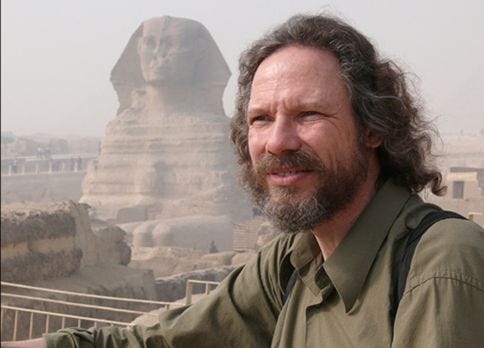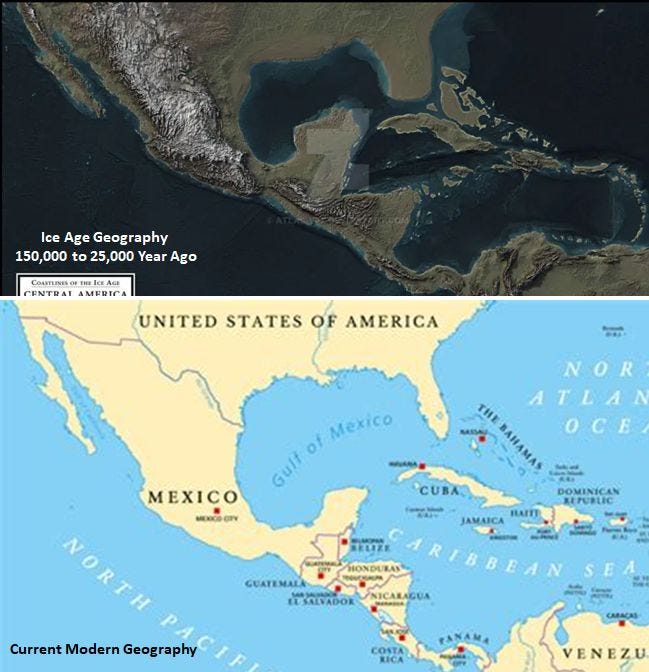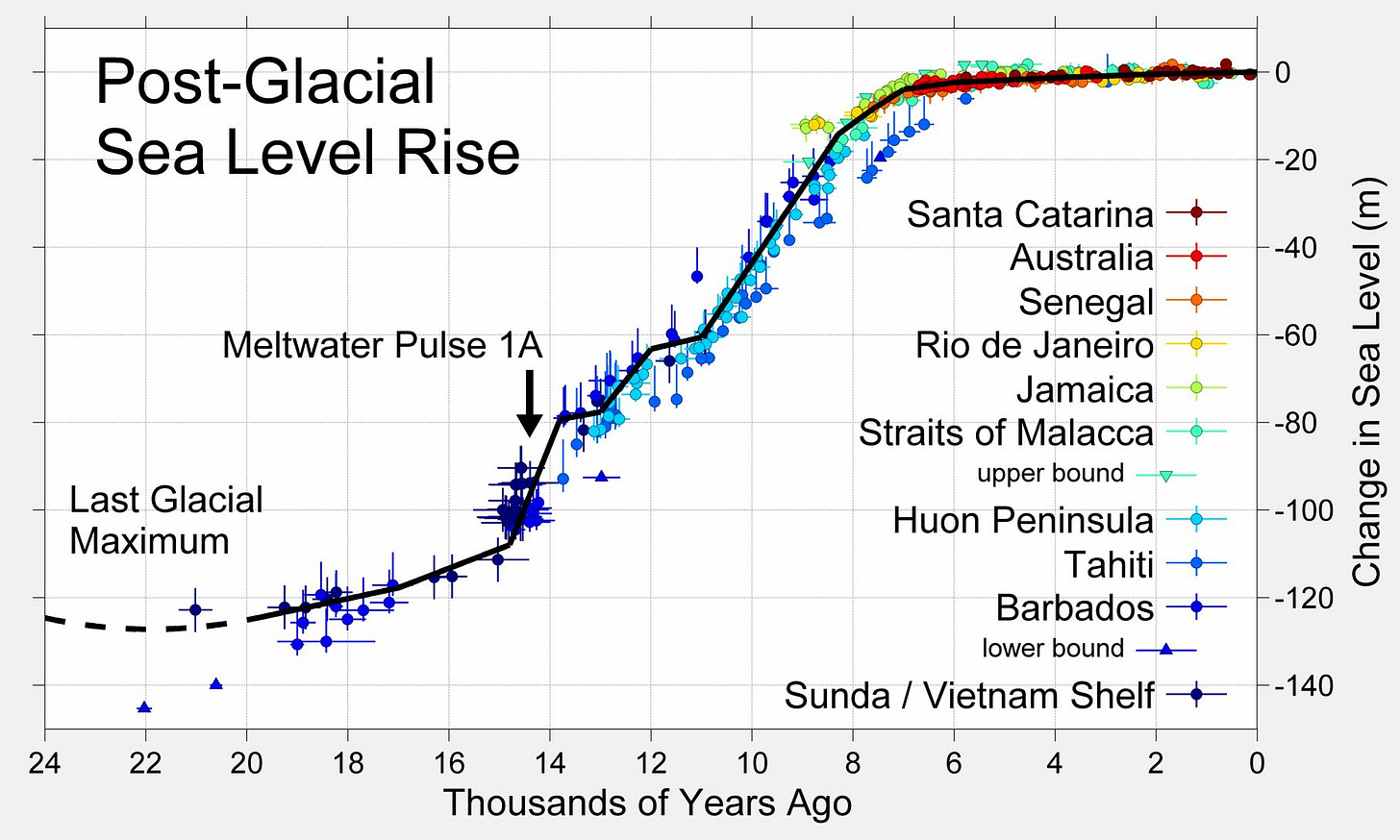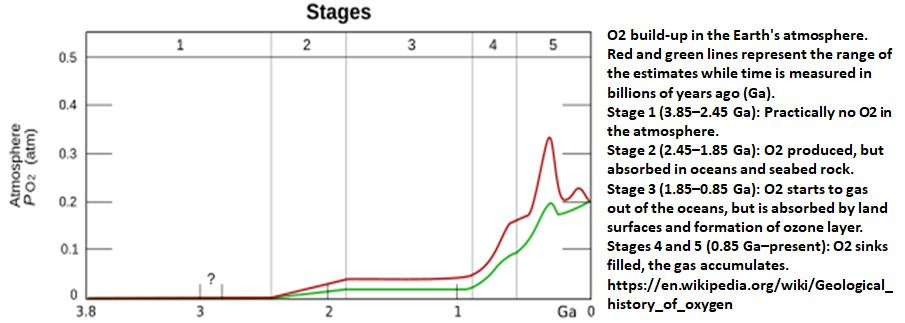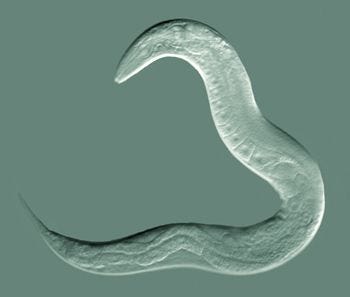Post 34: What Do The Effects of Pressurized Oxygen Tell Us About Humans? A Trip Down The Rabbit Hole.
Sometimes it's just good to post on stuff that is not related to the current craziness
I’m Not Saying This is Click-bait…
If you are having a tough time understanding this little pastiche of images, let me explain. The guy on the left is Giorgio Tsoukalos, the producer of the History channel series Ancient Aliens. The ideas that Tsoukalos promotes are based on the hypothesis that advanced extra-terrestrial civilizations came to our planet and helped or actually built the ancient structures that we see at Giza, Machu-Pichu or Tenochtitlan. Humans were taught the techniques or guided by these “gods” to build the great civilizations of the past. It’s all speculative interpretation of archeological evidence without a substantial factual data set.
The guy on the right is Graham Hancock. If he looks familiar, you may have seen him on Netflix (Ancient Apocalypse) or read one of his books that he has written. His work is compendial and multi-disciplinary, having written 22 books that span from local politics, history, anthropology, psychedelics, consciousness and archeology. He is best known for his hypothesis that human civilization is older than what is currently accepted by the academic archeological community - in some instances hundreds of thousands of years old.
But Wait! There’s More!!
Hancock has traveled the world, covering the news in Africa and Asia as a correspondent for multiple newspapers and magazines. This allowed him to see first hand many of the human-made structures from around the world. What struck him was the obvious mismatch between what he saw, what was taught and how out of place and how out of place in engineering capability these structures represented. The ages that the academic archeologists normally applied to the structures were bookended by the current idea that human civilization is 10,000 years old at its oldest. Anatomically modern humans evolved from archaic humans in the Middle Paleolithic, about 200,000 years ago. Much of what is taught in academic archaeology places the limit of modern human civilization at ~15,000 years old (just at the end of the Last Ice Age). No other civilizations could have existed further back…based on the current interpretations of the evidence.
Other researchers (whom Hancock highlights) that are brave enough (or sufficiently removed from the field of human archeology) have provided physical evidence that human structures are older than the mainstream believes. Dr. Robert M. Schoch (MS and PhD degrees in Geology and Geophysics from Yale University (PhD, 1983)) was invited to Egypt to analyze the weathering of the Sphinx.
Schoch knew classical Egyptology commonly dated the Sphinx to the Old Kingdom (c. 2558–2532 BC). But what he found truly astounded him…water erosion and water weathering that placed the Sphinx at about 5,000 to 10,000 BCE. This caused a huge controversy. Egyptologists dating of the Sphinx is based entirely on subjective interpretations, while geological dating is based on empirical notation. Water erosion is seen on the sides of the Sphinx and the walls of its enclosure. We know that at no point after 3,500 BCE was there sufficient rain to cause the erosion visible at the Sphinx site. Sufficient rain did occur before 3,500 BCE. However, we can't be sure at what point before then the Sphinx was built. So, this pushes the date of one of the most advanced cultures in Africa past the the accepted time of 5,000 years (since our present time) to well past 10,000 years.
When Schoch suggested that the Great Sphinx was much older than generally believed, Egyptologists asked, "Where is the evidence of an earlier civilization that could have built the Sphinx?". Egyptologist and archeologists were convinced that sophisticated civilizations did not exist prior to about 3000-4000 BCE. However, there is evidence of a high culture(s)? dating back to approximately 12,000 years ago, at a site in Turkey known as Göbekli Tepe. This advanced and high culture seemed to appear from nowhere and mysteriously disappear, only to reemerge thousands of years later in Egypt (or other parts of the region). Schoch builds a compelling theory for the existence of this pre-Egyptian culture in his book Forgotten Civilization.
Like Hancock, other researchers like Michael Cremo and Richard Thompson, have started from the hypothesis that modern humans have been around for waaaay longer than the academically agreed upon dates. They are vey clear that they are devout Hindu creationists, using this belief as the starting point in their analysis of the archeological record. In their analysis, they review the published archeological records, looking for anomalous findings that directly contradict the established time lines. Surprisingly, the find a great deal of data that cast doubts on the modernity of the genus homo sapiens sapiens.
Then There’s’ Mexico…
An excellent and modern example of the rigid adherence to the notion that no human civilizations (or modern human presence) could have existed (especially in North America) prior to 15,000 years, is the excavation of the Hueyatlaco site in Mexico. The amount of time, energy and resources put into properly dating and then attempting to overturn the results, is an example of the utter (and very religious) adherence to a narrative belief (by academics) of archeology instead of the data accumulated through the STANDARD methods accepted by mainstream archeologists:
"The evidence outlined here consistently indicates that the Hueyatlaco site is about 250,000 yr. old. We who have worked on geological aspects of the Valsequillo area are painfully aware that so great an age poses an archeological dilemma [...] In our view, the results reported here widen the window of time in which serious investigation of the age of Man in the New World would be warranted. We continue to cast a critical eye on all the data, including our own."
The controversy and the time spent in trying to dismiss or overturn the results is staggering. In 1962, the dig site was discovered. The site was secured by the researchers, uncovering butchered animal bones and stone tools. The stone tools and other implements were considered advanced and made by modern homo sapiens sapiens. Additionally, dating, based on stratigraphy (at what depth or layer of the soil they were found) were giving dates in excess of 20,000 years. Radiocarbon dating of the animal remains produced an age of over 35,000 years. Uranium dating produced an age of 260,000 years to give or take 60,000 years.
Every attempt to push back on the results has resulted in confirmation that the results are not only correct but may be even older!
Biostratigraphic researcher Sam VanLandingham has published two peer-reviewed analyses that confirm the earlier findings of ca. 250,000 ybp for the tool-bearing strata at Hueyatlaco. His 2004 analysis found that Hueyatlaco samples could be dated to the Sangamonian Stage (ca. 80,000 to 220,000 ybp) by the presence of multiple diatom species, one of which first appeared during this era and others that became extinct by the era's end. VanLandingham's 2006 paper refined and re-confirmed his 2004 findings.
So, there is evidence of modern human habitation in America that contradicts the standard model of human migration and presumed evolutionary (biological and cultural) sequence. Other anomalies, such as the human (modern) foot prints fossilized in sandstone, at the White Sands National Park in New Mexico, indicates that the 21,000 to 23,000 year time frame for human habitation has confirmation in other areas of the Americas.
So what does that mean? There is too much physical evidence that points to a much older dating of human history, civilization and engineering capability. Until a plausible counter argument is provided that can explain the rather sweeping amount of evidence for a greater antiquity of human civilization, I will go with the idea that humans are older than the accepted standard model. This means that we have been around in our current form for a lot longer. And we may be adapted to a very different world than the current one we live in now.
Ice Ages and the Real Climate Change
For the past 15,000 to 25,000 years, we have been climbing out of an Ice Age, living through a warming trend that has resulted in receding glaciers and rising coast lines…but not in recent memory. This warming trend has zero to do with CO2 or human induced warming. Prior to the warming trend, we were living in a world where coastlines and sea-levels were markedly different! The Ice age world of North America and the Caribbean had vastly more land mass, as displayed in the image below. Prior to the sea-level change there was vastly more land mass exposed and given the preponderance of human habitations being constructed close to oceans or rivers, its not impossible to believe that many cities and towns are waiting to be discovered in the shallower areas that are indicated in the Ice Age geography image.
World ocean and sea-levels were about 300-500 feet lower (or more), compared to modern maps. This was probably the state of the world for hundreds of thousand of years…maybe even a million.
This is where we have to ask ourselves a few critical questions.
If the current crop of academic archaeologists have been ignoring data that does not fit the established narrative for the field, how trustworthy is the current timeline for humanity?
The idea of worldwide floods, which are shared from Inuit, Cherokee, Babylonian, Sumerian, Hebrew, Egyptian, Indian and Polynesian cultures (just to name a few) describe an event that could only have occurred in the recent past (within 25,000 years).
The amount of land mass that was consumed by the sea-level rise is significant. This means that there may be vast tracts of human cities and towns covered by these oceans.
The evidence that cities once thought mythical are real has its best example in the excavation of the city of Troy. Troy is known through the writings of the poet Homer and the stories of Virgil. In the 1870’s through the work and funding of private archeologists, Troy was unearthed in Turkey, within the province of Çanakkale, some 30 km south-west of the provincial capital, also called Çanakkale.
The work of Paulina Zelitsky, a Polish-born deep ocean engineer that claimed discovering megalithic structures of the western tip of Cuba (WayBack Machine) in 2001 at a depth of 0.5 miles. Zelitsky had previously discovered the wreckage of the U.S.S. Maine in November of 2000 of the Cuban waters, as part of a team of researchers exploring the area. Since that time, the claims of a submerged city with Aztec or Central American pyramid structures have been disclosed.
The Underwater City in the Gulf of Cambay is a huge submerged city off the western coast of India, 120 feet (36 meters) below sea level. It was discovered accidentally in 2001 by Indian oceanographers who found enormous geometrical structures with a side-scan sonar. Marine archaeologists found construction material, sections of walls, sculpture, pottery, and human remains. These were carbon-dated and found to be about 9,500 years old. This corresponds with the end of the Ice Age some 9,000 to 10,000 years ago when the melting of the ice caps elevated the sea levels and probably also submerged the ancient city in the Gulf of Cambay. If the Underwater City in the Gulf of Cambay is as old as it appears to be, it predates the earliest known cities in Mesopotamia for as much as 5,000 years.
These small samples of archeological remains tell us one thing…the narrative of human ancestry is far from complete and very wrong.
Oxygen and Pressure - Changes over Humanity’s Time
So, we have evidence that points to our ancestors being around the world for a much greater time than we appreciates. This amount of time allows for the slow and subtle push of evolutionary selective pressures to take hold. The current evidence suggests that modern humans and our civilizations have been around for more than 100,000 years (or even older).
The human species has been exposed to changes in atmospheric pressure and oxygen concentrations for much longer than we realize. Sea-levels have changed and the best estimates suggest hundred of meters have been lost…if not more.
https://en.wikipedia.org/wiki/Past_sea_level
One very interesting aspect is the effect of varying both pressure and oxygen concentration on the mammalian system. When mammals, including humans, are placed in a pressure vessel and the oxygen level is kept the same or elevated, cells and organelles in the body react in a way that helps to fight disease and regenerate tissues!
Prior to the development of pressure chambers(1600-1900’s), many doctors that had patients recovering from pneumonia, tuberculosis or heart conditions would prescribe or suggest that the patient take a vacation “by the sea”. Although physicians in pre-industrial times did not know why there was health benefits to being at sea level, they did see clinical benefit for the majority of their patients.
We now know that the lowest point, and the highest pressure, can be achieved naturally at sea-level. This provides a number of health benefits for individuals - cardiac function is improved, breathing function and oxygenation increase, lung infections can be fought off more successfully. The modest change in air pressure (while keeping the percent oxygen the same) does provide amazing benefits.
When you can go below sea-level, say the Dead Sea (which sits 1412 feet below sea level), you are at a barometric pressure of 800 mHg (or 1.05 ATA). Sea level air pressure is at 760 mmHg (or 1.0 ATA). The number of verified benefits of being below sea-level range from improved pulmonary rehabilitation of hypoxemic patients with COPD, improvement of heart function after healing from an acute myocardial infarction, improvement of cardio-pulmonary function of patients with cystic fibrosis and improvement of oxygenation and exercise capacity in patient with end-stage lung disease.
Mitochondria, the organelles that make the energy used by cells, love oxygen. As a matter of fact, they can repair themselves, make new copies of and improve the efficiency of their energy production when given oxygen at an elevated pressure. With mitochondrial effects, you get a number of cellular and whole body effects!
Additionally, recent studies on the effects of cellular senescence show that sustained and multiple exposures to 100% oxygen at pressures of 1.5 to 2.0 ATA produce a wide range of cellular repair and increasing the viable life-spans of cells. One key aspect of the recent studies of frequent treatment with hyperbaric oxygen (60 sessions, 1 hour per session, 100% oxygen at 1.5 ATA) resulted in telomere LENGTHENING. Telomeres are the repeating end caps on chromosomes that protect the DNA from degradation when cells divide - each division reduces the length of the telomere and when cell divide too many times, the chromosomes start to break, DNA information in lost and cells enter into a senescence. Senescence is best described as not dead, but limping along - in essence not supporting the bodies function but not being too much of a drain on the body. With the ability to maintain telomere length - and turbo-charged mitochondria - hyperbaric oxygen appears to have the ability to increase longevity and act as an anti-aging strategy.
Given all this data, homo sapiens sapiens evolved (or was created or migrated from off planet - gotta cover all the bases, right!?) into an environment that was richer in oxygen and at a higher pressure. The right kind of condition to allow for potentially improved and longer life spans.
The Mythology of Long Life Spans
Humans have been around for a lot longer than what is generally accepted by the academic community. We lived in conditions that were waaay more favorable for longevity and health than current times.
For now, let’s assume that 95-99% of the academic institutes are captured entities shaped by Invisible Colleges that adhere to a Rockerfellian (dare we say, Fabianesque or Occult) school of thought? The modern adherence to materialism (as opposed to or parallel to spiritualist, dualist or electro-magnetics world-view) as a guiding philosophy has lost the plot. The knee-jerk reaction to poo-poo the records associated with religious writings or other non-technical records is a vast and lost opportunity. There are vast historical records and written traditions that are scattered across the globe that may contain important clues to this central thesis. This includes the known and presumed records of the Holy Roman Empire/ Vatican. The time span of the records kept by a fallen Empire that was converted into a religious order exceeds 3000 years…that is a long time.
The New York Public Library Main Branch, at the time of the branch's opening, held 2.7 million books on 63.3 miles (101.9 km) of shelves. Current estimates are well above 200 miles of books at the main sites of the main branch. The library opened and began accepting books in 1906. Now, if a modern library, in the heart of one of the great cities of the world and funded by the wealth of robber barons and the NY State legislature, has that many books, what are the chances that the Holy Roman Empire does not have archives that dwarf the 119 year old library system?
The Vatican archives have been looted from around the world, housing knowledge from thousands of traditions and cultures, secreted from the Library of Alexandria, Tibet, India and even more ancient civilizations (pre-Sumer). The archives are rumored (and in some cases confirmed) to have more than 50 miles of shelves. That sounds like a low number, when you consider the vast network of tunnels that run under the Holy See and other properties that the Vatican controls all over the world.
In many of those records, including the Christian and Jewish books, claims of the longevity of the patriarchs (and matriarchs) was much greater than today.
The mythology concerning human longevity in the past is extensive. The first ten men mentioned in the Bible, Adam through Noah (except Cain and Abel), lived on average more than 850 years (Genesis 5: 1-32). Methuselah lived for 969 years. This was the maximum, but by no means exceptional. However, already in antediluvian time God fixed the living day of man to 120 years. Apparently, it took some time to adjust to this standard. The mean longevity of the eight male generations from Noah to Abraham was close to 300 years. There was a clear and statistically significant tendency to decline (r = -0.88, t = 4.58, df = 6, p < 0.001; Genesis, 11:10-26). (See Human Longevity)
Additionally, the 4,000-year-old Sumerian King List—shows a steady decline in lifespans, paralleling the lineage seen in both of the Jewish and Christian writings. The Sumerian King List differentiates between pre-flood and post-flood reigns. The pre-flood reigns are significantly longer than the post-flood, though even post-flood lifespans are shown to be several hundred years or more than 1,000 years.
Much of the “evidence” for longevity in the antediluvian past is of written or oral records, making the physical assessment for longevity not possible - and the skeletal record would be difficult to assess for such enhanced longevity; how would you assess the actual age of the bone? Is there a way to measure the actual age of the human via the bone record? The written history or tradition is the only basis for believing that such long lifespans are possible for humans…but they do correlate and are consistent with traditions from around the globe that coincide with the time and the established oxygen/pressure conditions that existed at the time on Earth. If there is evidence for these very large lifespans, the historical written record should have it memorialized - and it is likely in one of the oldest repositories of information on the planet: the Vatican archives.
What Current Biological Evidence Demonstrates for Oxygen and Pressure Effects in Longevity?
The nematode (microscopic worm) Caenorhabditis elegans (or C. elegans) is the workhorse for biological research, being the first organism to have its genome completely mapped, its life-cycle completely described and every cell and cell type mapped, from fertilization to death. This organism serves as a test bed in cancer research, Ahlzeimer’s research and longevity research.
One of the effects associated with C. elegans being exposed to hyperbaric oxygen (HBO) is the increased levels of reactive oxygen species (ROS). ROS molecules are a byproduct of mitochondrial respiration and can induce damage to cells and the DNA. C. elegans (and all other organisms) have developed systems to counter the damage, and in so doing they get a huge benefit…longevity. This effect is know as hormesis, a biphasic dose-response characterized by low-dose stimulation and high-dose inhibition. Hormesis is a toxicological concept to account for the beneficial effects of mild stress.
In the literature, brief but frequent exposures to HBO at 1.5 to 2.0 ATA (100% oxygen) have demonstrated the ability of high pressure and high oxygen to affect physiological processes at the genetic level by altering gene expression, delaying cell senescence, and assisting in telomere length enhancement. The positive results in a variety of indications, ranging from tissue regeneration to better cognitive function and in anti-aging. The few experiments that have looked at long-term exposures to elevated oxygen levels indicate that a hormetic effect is present and beneficial. This is borne out by the effects seen in patients getting treated in the Dead Sea environment, spending weeks to months at that location and seeing health effects that can last for months.
It is not outside the realm of possibility that in the time periods greater than 25,000 years ago (probably 50,000 or more), the human population lived at pressures that where in the range of 1.05 to 1.1 ATA and oxygen concentrations of 22%-25% . In experiments with hyperbaric air (1.5 to 2.0 ATA at 21% Oxygen), stroke damage has been reversed or protected against by using pressurized air (gerbil and rat models). Even pressures as low a 1.05 ATA have a measurable effect on cell culture.
This observed phenomenon in mammals suggests that we are as species (and most mammals) evolved or were optimized to live in an environment that allowed for these hormetic effects to occur. We are tuned to respond to higher levels of oxygen at higher pressures. At lower pressures, say at elevation greater than 10K feet, we tend to see altitude sickness symptoms and require extended acclimatization to these higher altitudes.
It would be interesting to observe the effects of a mildly pressurized environment (say 1.1 ATA) at 25% Oxygen on the longevity of rats or mice or C. elegans (or all three) when raised over multiple generations under those conditions. It may shed light on the prospect of longevity in the paleolithic era and allow us to more factually assess the potential for these mythically long ages recorded in humans. I believe that the role of the atmosphere (both in terms of pressure and oxygen concentration) will provide good evidence that it is possible to achieve greater longevity.
In Summary
The work that has been done by the mavericks in the field of archeology and human antiquity cannot be disregarded out of hand. The evidence that the current timeline for humanity’s ancestry needs to be reassessed is long overdue - our human lineage and civilization is older than what we are being told. Our connection and continuum to a civilization has been broken by sudden and dramatic changes in our environment. Attempts to deny that global floods (one event or multiple events) and cataclysms have come up against verifiable facts that are difficult to fit into the standard narrative we have been taught. Global events occurred recently to alter the world in a dramatic fashion and wipe out or submerge evidence of advanced cultures.
The writings of longevities in the multiple hundreds of years that academic scholars consider mythical or lacking in rigor are objections based in Normalcy Bias - allowing what you are acclimated to accept as normal as being universally normal. Human longevity, much like human performance, keeps on being pushed to greater limits. What we currently perceive as the norm is purely based on the current state of the world we experience - a kind of temporal provincialism that is untethered to traditions learned and passed on in civilizations and cultures that have fallen into myths.
We are now in an age where knowledge generating and curating institutions act as gatekeepers and censors, not good faith actors in discovering the truth. When evidence that is presented that contradicts the accepted NARRATIVE, mighty engines of control are in place to ensure that information is not let out, becomes highly discredited and those pesky CRITICAL THINKERS are run out on a rail.
Hope this rabbit hole was fun!
BTW - if someone knows Graham Hancock, please send him this link!
Until next time.
Tell a friend.






